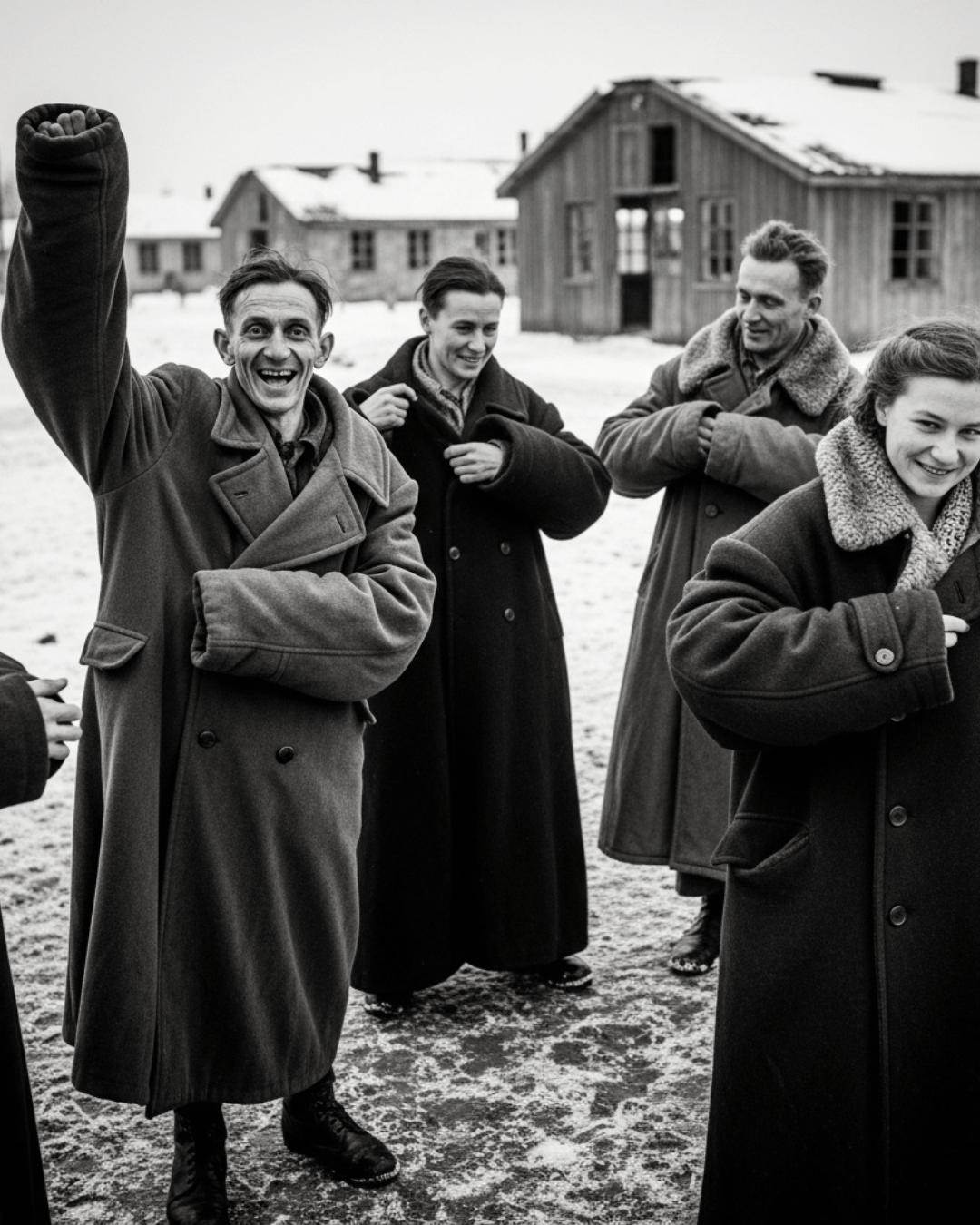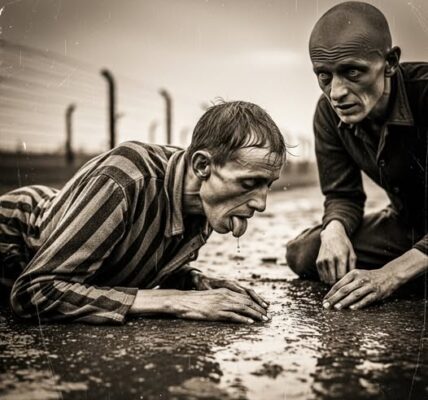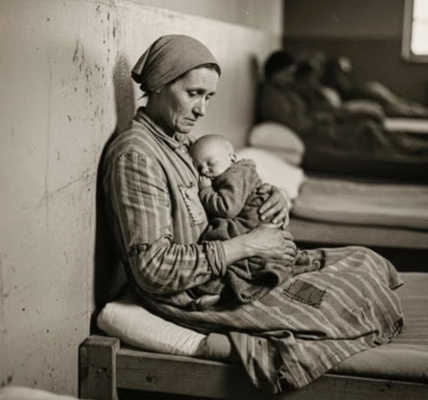The coats of Bergen-Belsen: when warmth became human again
December 1945.
Snow slowly blanketed the gray barracks of Bergen-Belsen, as if the sky wanted to bury beneath its white veil what the earth still refused to forget. The camp, now in Allied hands, was silent, almost motionless. Yet, amidst the ruins, there remained beings, emaciated figures with gaunt faces, who were learning each day how to become alive again.
Those who had survived the liberation in April were still there, in what was now called the displaced persons camp . Their freedom was not a cry, but a hesitant breath. Their bodies, marked by hunger and disease, sought warmth, trying to readjust to the sensation of cold on their skin—a cold that no longer came from the striped uniforms, but from the winter of northern Germany, so different from the one they had known behind the barbed wire.
It was in this suspended atmosphere that a humanitarian truck arrived one morning, raising behind it a cloud of snow mixed with mud. On board, workers from the Red Cross and the Relief Committee were transporting packages of clothing sent by British, Swiss, and Canadian civilians — donations gathered in the name of a simple cause: to warm those whom the war had frozen .
When the crates were opened, a murmur rippled through the crowd. Inside were coats. Hundreds of coats, all different: long, short, threadbare, fur-lined, or misshapen by time. Some smelled of mothballs, others still carried a distant scent, a trace of a life before.
The survivors crowded around, hesitant at first, almost ashamed to reach out. Then, little by little, bony fingers grasped the fabrics, feeling the wool, the velvet, the cracked leather. There were no exact sizes, no matching colors, no mirrors to check. The men and women tried on these coats as if they were new skin.
And suddenly, the camp came alive. Laughter erupted—harsh, astonished, unprecedented laughter. A man raised his arms, his overly long sleeves swinging in the air like the wings of a clumsy bird. A young woman clutched her fur collar to her neck, her eyes shining with a forgotten pleasure. Another, with a mischievous glint in his eye, spun around to show off his oversized coat: “Look! I look like a general!”
The British soldiers, witnessing the scene, remained frozen for a moment, then smiled. Some discreetly wiped away their tears. This spectacle, so simple and so disconcerting, spoke louder than any speech: after months of nightmare, the survivors rediscovered the joy of getting dressed, the warmth of fabric, the lightness of laughter.
For those who had experienced winter in concentration camps, these coats represented far more than protection against the cold. They were proof that the outside world still existed—a world where unknown and free people had thought of them, had chosen to give without expecting anything in return. Every seam, every button, every lining carried within it a trace of rediscovered humanity.
Those who witnessed that day remembered the snow melting beneath their feet, the pale morning light, and that strange feeling: that of no longer being invisible. Those coats offered physical warmth, certainly, but also moral warmth—the conviction that kindness could be reborn, even after utter inhumanity.
A survivor later wrote:
“When I put on that coat, I felt for the first time that someone, somewhere, wanted me to live.”
In the days that followed, the camp courtyard became a stage for impromptu performances. Some exchanged their coats for others, more suitable, prettier, more practical. Others kept whatever was available, refusing to part with the one that had restored their sense of touch. Disparate figures could now be seen moving between the barracks: here, a British soldier’s coat on the body of a Polish teenager; there, an elegant London gentleman’s overcoat draped over an emaciated old man.
This diversity of clothing told, in its own way, the story of the meeting of worlds: the broken post-war world and the intact one that was trying to repair itself. In each sewn-on button, there was a silent message: You are not alone.
And perhaps it was this, even more than food or medicine, that saved these wounded souls: the feeling of belonging to humanity again.
But the symbolism of the coats went even further. In both Jewish and Christian traditions, clothing represents dignity. To be clothed is to be recognized as a human being. The Nazis had stripped their prisoners not only of their possessions, but of their identity: they had taken their names, their hair, their clothes. By offering these coats, the free world restored to each individual the most fundamental right: the right to cover themselves, to choose, to be warm or cold for themselves.
The photographs taken that day bear witness to this suspended moment: men and women smiling shyly, turning up their collars against the icy wind, discovering with astonishment the sensation of clean fabric against their skin. Some raise their fists, not in defiance, but in joy. Their eyes, still marked by suffering, allow a new light to filter through: the light of survival.
As the weeks passed, the camp was transformed. Aid workers set up kitchens, schools, and workshops. Children learned to read in several languages, and women picked up the threads of their interrupted lives. But for many, that specific memory—of winter coats being distributed in the snow—remained a turning point, a rebirth.
Decades later, several survivors still spoke of that day with undiminished emotion. “We laughed, for the first time,” they said. And in their voices still trembled gratitude for those invisible hands that, thousands of kilometers away, had knitted, sewn, and prepared packages, perhaps believing it was just a simple donation. They didn’t know they were sending far more than fabric: they were sending proof that the human heart had not been lost in the war.
Today, in memorial museums, some of these coats are still preserved. Their worn linings and rough seams tell a story that words cannot adequately express. Beneath the glass cases, one can read these inscriptions: “Coat given by a British family to a survivor of Bergen-Belsen, winter 1945.” It is not simply an object; it is a fragment of a soul.
The visitor who pauses before these coats can almost feel the chill of the camp, the breath of the wind on the frozen plain, and the sudden burst of laughter amidst the ruins. This laughter, fragile yet genuine, still resonates today as the most beautiful response to barbarity: humor, warmth, life.
In a contemporary world often saturated with information, where the Holocaust is spoken of as a distant chapter of history, this scene from 1945 reminds us of a simple truth: humanity always rebuilds itself through the simplest gestures. Offering a coat. Sharing a meal. Holding someone’s hand. These acts, seemingly insignificant, repair what ideologies destroy.
And this is the whole meaning of the bread and the coat of Bergen-Belsen: two acts of survival that have become two symbols of hope. One nourishes the body, the other envelops it. Both remind us that, even after the darkness, there is always a flame left to pass on.
The coats of Bergen-Belsen are therefore not merely a post-war anecdote. They embody the continuity of human kindness, that quiet strength that transcends centuries and catastrophes. And while history remembers battles, speeches, and treaties, it remembers above all these moments of grace—those when human beings, broken but standing, laughed in the snow, wearing oversized coats, rediscovering in a burst of joy their right to warmth and to life.
Note: Some content was generated using AI tools (ChatGPT) and edited by the author for creative reasons and suitability for historical illustration purposes.






